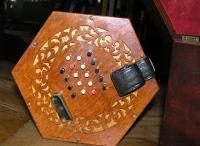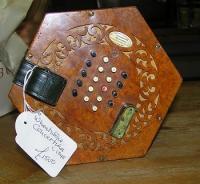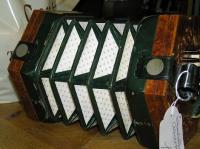-
Posts
518 -
Joined
-
Last visited
Everything posted by Robin Madge
-
It does make a detectable difference to the sound, might even be more of a difference for the audience, remember that they don't get quite the same sound as you do from their position. I think it helps to be able to play stacatto and then you can relax and let things more legatto whe you want. If you are releasing pressure by playing the note after the bellows direction change you will have more "attack" to the note and will have more of the "Anglo punch" to it. The faster the tune the less possible it is. Robin Madge
-

Anyone Going To Fylde Folk Festival?
Robin Madge replied to Robin Madge's topic in General Concertina Discussion
Well Fylde is over for another year and it was a splendid time. We didn't get to see many of the performances because of the time-tabling of what we were involved with, Wrigley Head morris having two dance spots each day and a parade to take part in as well. In addition I helped the Lancaster Pace-eggers out as they start their performance with the Wyresdale three-legged dance. It has other names but basically has three dancers who intertwine their limbs in various contortions and spend a lot of time staning on one leg each. Several of the figures are depicted in pre-Roman Celtic art. Didn't get to see many concertinas being palyed as a result but I do know that a Morse C/G was sold to one of Captain Cooper's Motley Crew. I would say it is a festival well worth investigating if you've never been. Robin Madge -

Anyone Going To Fylde Folk Festival?
Robin Madge replied to Robin Madge's topic in General Concertina Discussion
I've just found the house details and it's going at £370,000 . Somehow I think you'd rather spend it on concertinas! It was an interesting house though, 3 bedrooms downstairs and the living room and kitchen/diner upstairs, with two more low height rooms in the roof space. Robin Madge -
Anne and I shall be playing for Wrigley Head Morris Men at Fylde Folk Festival, Fleetwood near Blackpool, this coming weekend and no doubt heading for some sessions as well, so come and chat if you see us. This is the Festival run by Alan Bell, of stolen and recovered concertina fame. Chris, I gather you and Anne will be "up north" but I imagine that we will not manage the "Hale and Hearty" on the Friday as we shall probably be at Fleetwood. (There's a nice house for sale within walking distance of the Hale club, by the way. It comes with 6 acres of woodlands as well.) Robin Madge
-
Perhaps the thread title says it all. Should your next goal be to play and sing "I'm a believer" by the Monkees ? It comes out quite nicely on Anglo. Robin Madge
-

How Many English Players?
Robin Madge replied to Jeff Stallard's topic in General Concertina Discussion
The traffic lights reminded me of the driver who explained to the judge that it was the doppler effect on the red light that had caused him not to stop when he should have, as he thought it was a green light. He was fined for speeding! Robin Madge -
The closest thing I can think of is the sound that you get if you amplify a concertina and put the signal through a phaser or digital delay pedal ( I've done both!). Robin Madge
-

How Many English Players?
Robin Madge replied to Jeff Stallard's topic in General Concertina Discussion
You need more folkies than that. There's got to be someone there to complain that it is electric! Robin Madge -

Hearing Difficulties?pardon?
Robin Madge replied to Alan Day's topic in General Concertina Discussion
Some people are just lucky. So far I don't seem to be affected, although I don't hear bats like I used to in my 20s, so I suppose the top end is going. I have survived full volume folk-rock practices in my living room, that made my ears ring until the next lunch time, and some very noisy DIY tools, but you can't assume that everyone has the same tolerance. My wife's father and his brother worked side by side in the same factories. One lost a lot of his hearing, the other died from the effects of the dust. Niether had any symptoms of the other's complaint. Part of hearing problems is to do with how the brain interprets the messages that it receives rather than the hearing organ itself. I find it more difficult to understand speech when in noisy environments such as parties than other people who cannot hear things that I can. I put that down to the brain rather than the ear. My wife says that she cannot hear as fast as I can. That is why she doesn't like fast Irish music as she's only getting the first note in every bar. Some tunes are very monotonous if that's all you can hear! Robin Madge -
Kieth Kendrick spent about 6 months working at the Japanese Disney Land as a singing pirate. He came back sick and tired of "South Australia" so I suspect he was mainy using the Anglo. Robin Madge
-

Tobacco Sunburst Aeola
Robin Madge replied to Bob Tedrow's topic in Instrument Construction & Repair
Gordon Johnson put flashing Christmas lights inside his clear top banjo to be seasonable. Don't quite see it with a concertina though. Robin Madge -
I just remembered some possibly relevant information on the "Doppler effect" front. I once recorded myself "doing the bells" using a fixed position microphone about 8 feet in front of me. I could hear the Dopler effect quite clearly. I repeated the recording using Microvox microphones attached to the ends of the concertina. I could still hear the effect. How does that work? Robin Madge
-
Just to give examples of how I move the concertina to give emphasis and/or create effects. 1. Sitting holding the concertina with the left end on the left knee. Tap the left heel up and down on the floor to shake the whole instrument. 2. Sitting as above. Increase and decrease pressure, without changing bellows direction, pivotting the right arm from the elbow. How fast you can manange the vibration depends upon your muscle tone! 3. As above but use the shoulder muscles to shake the whole right arm. 4. Sitting as above change the angle of the right hand end of the concertina with respect to the left hand end by about 20 degrees towards the front so that the axis projected from the left hand end extends through the right wrist, and then rotate the right hand end alignment about this axis. This will change the perceived volume of the right hand end of the instrument (usually playing the melody) for an "audience" placed in front. 5. Standing. Swing the whole instrument in a vertical/side to side circle keeping the arms fairly straight (doing the bells). Gets tiring after a while, and don't let go! 6. Standing. Move the whole instrument in a horizonal circle side to side/ towards and away from you. This is what Alistair Anderson often does when he gets into the music, to emphasise a particular note. There are obviously plenty of other movements/positions to experiment with (I can play some things behind my back and behind my head as inspired by Jimi Hendrix but can't think of a way of using my teeth!!). Robin Madge Editied to add the word "alignemnt", I didn't mean twist the end off!
-
Reading through the previous cotributions I think that we have agreed that Tremulo is a variation in volume and Vibrato a variation in pitch of the note. The trouble is that when you vibrate one end or both ends of the concertina it will change the volume no problem, but it will also change the percieved pitch of the note because of the Dopler effect. Now I know that this is a very small effect, but it is there and discernable on occasions. As to vibrato as an enhancement to the mood of the music, I would suggest watching Alistair Anderson. He gets a lot of his enhancements by moving the instrument about to create emphasis, not just changing the volume but also the percieved pitch. I don't suppose anyone has done any quantative research into this? Robin Madge
-

How Many English Players?
Robin Madge replied to Jeff Stallard's topic in General Concertina Discussion
What does Dave Brady, the one armed member of Swan Arcade, play? Robin Madge. -

How Many English Players?
Robin Madge replied to Jeff Stallard's topic in General Concertina Discussion
I have a theory that may go some way to confusing the situation further. I have always had the impression that most English players read from the dots and most Anglo players play by ear. This seems to be changing as more people seem to be able to do both nowadays. Asuming that you read from the dots, you are more likely to play "band" music and get together in a formal situation which in turn means you are more likely to become a member of an organisation, such as the ICA or the West Country Concertina Players, where you can arrange such meetings. I think this will mean that there will be more "independant" players of the Anglo, who never get counted by the usual data gathering exercises, as they are effectively invisible. On several occasions people have come up to me after seeing me playing, saying that they have an old concertina at home that they can manage one or two tunes on but they don't consider themselves as players, and they are nearly always talking about an old 20 or 30 button Anglo. Robin Madge -
Just wondering, if you live alone are you more likely to vote in the poll, as you have more time to read it, less distractions etc? Robin Madge
-

Squeezing On Holiday/vacation
Robin Madge replied to bigsqueezergeezer's topic in General Concertina Discussion
The in-car music stand. It is a table-top music stand placed against the passenger dashboard and supported by the drop down flap. Unfortunately the flap doesn't project far enough for this to be stable when the car accelerates so I have increaced the angle by placing a couple of plastic clamps on the edge of the flap, sticking out towards the passenger, and supporting the music stand on these. The clamps I have are moulded plastic, available in a range of sizes, and have a hollow back to the handle that the stand legs can sit in. Robin Madge -

Squeezing On Holiday/vacation
Robin Madge replied to bigsqueezergeezer's topic in General Concertina Discussion
As for playing the concertina in the car, one of Anne's christmas presents a few years ago was a music stand that can be used in the passenger seat. It sits on a couple of plastic clamps placed on the open passenger dashboard cover (I wonder what the correct termnology is?). Otherwise it is an ordinary table top music stand. Robin Madge -
Whilst at Ely festval we had a look round the antique shops and came across this 38 key Wheatstone english for sale. It has number 670 on the ends and is supposed to have some signatures inside, though I couldn't make out who is supposed to have signed it. The shop let me take some photos so here goes at posting them. Robin Madge.
-
But the blades are angled and there will be a suble difference in the direction that the sound is reflected in between the blade being in one position, and then moving to a position that is halfway before it reaches the place the preceding blade was in. (I hope that makes sense!). The fewer the blades the more obvious it would be. Anyone tried fans with different numbers of blades? Robin Madge
-
Has anyone yet considered that the fan may also be acting as an amplifier? The intermitant reflection from the passing blades will bounce the sound back louder than when the sound passes through between blades. The will give a warble of volume rather than a warble of pitch. John Waltham, the folk singer/farmer, told me that tractor drivers communicate to each other across several fields by revving up the engine and shouting through the exhaust, using it rather like a carrier wave. Robin Madge
-

The "english" Style Of Anglo Playing
Robin Madge replied to Chris Timson's topic in General Concertina Discussion
I see what you mean Wes. But having decided that you want to play a particular tune that is lying there half in, half out of your subconscious, you are going to get a different feel to it depending upon what instrument you play. Of course, if you are a very good player you will be able to reproduce it perfectly, but mostly you'll get "the truth, the whole truth, or something like the truth". I would say that the mistakes that we make but are prepared to live with are part of what makes the style we play in, and that some of these mistakes are to do with the fact that the instrument is an Anglo. How we remember the tune will also be affected by the other music that we are familiar with. Cecil Sharpe was amazed that some of his singers were using the mixolydian mode, as he considered it a rarity confined to intellectual circles. They cnsidereded it completely normal. Robin Madge -

The "english" Style Of Anglo Playing
Robin Madge replied to Chris Timson's topic in General Concertina Discussion
Just a thought on the continuity of English harmonic traditions. Remember that the musicians in the West Gallery choirs are the same musicians who played at the village dances (just read some Hardy). If you examine what is going on in the West Gallery music you can see how the idea of the harmonies used there will extend into what was played at the dance hall. Now I know we are predating the concertina here but I don't see why we can't extend backwars and forwards from this to see a continuing tradition. Robin Madge -

The "english" Style Of Anglo Playing
Robin Madge replied to Chris Timson's topic in General Concertina Discussion
I think that I might be being a bit heretical here but I'm not sure that the English style of playing is to do with learning from dots or from other players. For me the style I play is to do with the instrument itself and how it relates to the sound I want out of it. I'll leave it to Chris and Wes to decide whether I quallify as playing in "the" English style ( plenty of debate to come about how many English styles there are, no doubt). I just learnt to play without much, if any, influence from other players except by listenig to recordings, and mainly I was listening to entire bands, not solo performers. I found tunes that I wanted to play, found a way of playing them and did it. I found that I could play a lot of the tunes in octaves using both sides of the instrument, and filled in chords with the spare fingers left over. At first I didn't do much cross row fingering, but again that was as much a feature of the tunes that I wanted to learn. So I have a style that can sound a bit like William Kimber when playing Morris, but not learned from listening to recordings of him, a bit like Alan when I'm playing "Rosbif" tunes, but only from listening to the group as a whole, and a bit all my own because I'm just too stuborn to change what others might see as mistakes and I consider as "features" of my style. So I think that I am saying that the "English" style is partially inherent in the instrument and that this may have become disguised by people being too determined to learn things "exactly", by reference to dots or to tabulation or too much emphasis on which finger to use. Have you noticed how at concertina weekends that the English system player form a band, the Duet players play jazz and complicated arrangements, and the Anglo players discuss how many different styles ther are to play the same tune? Robin Madge




